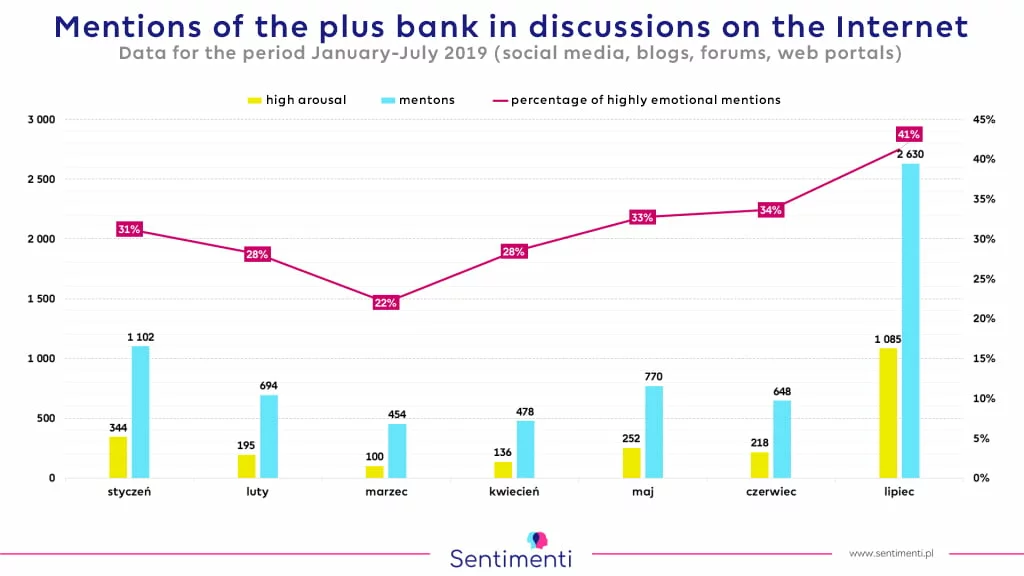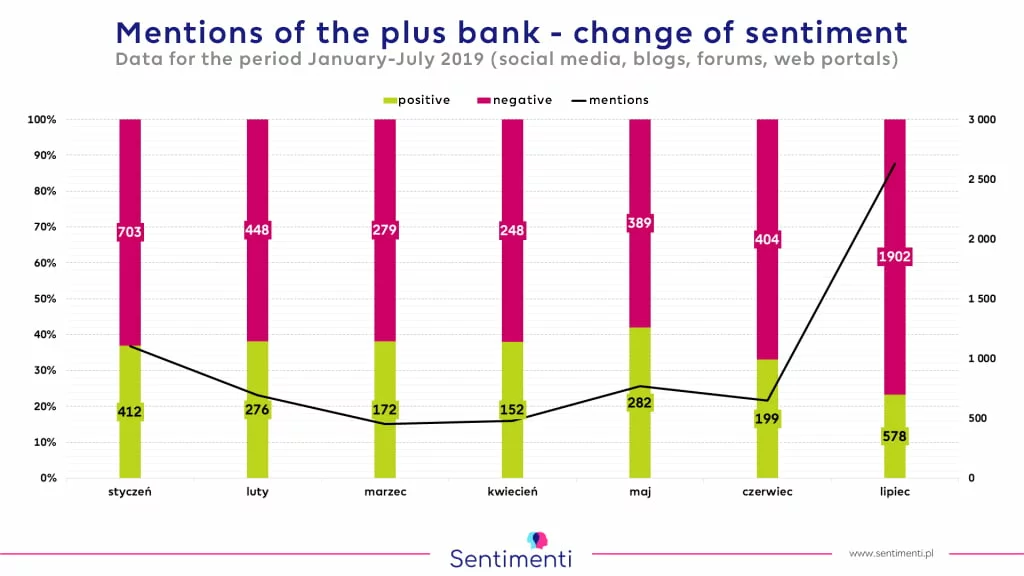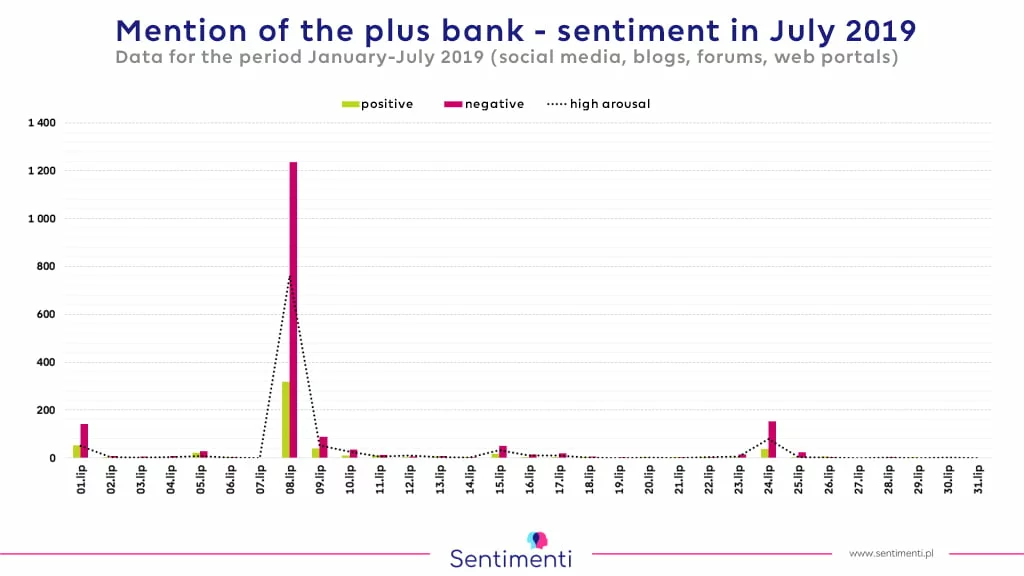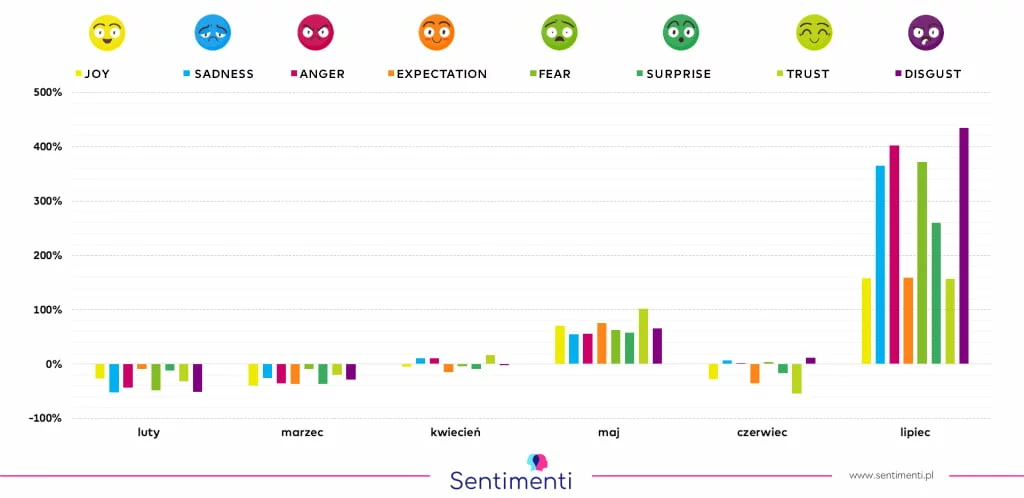
by Damian Grimling | May 12, 2020 | Sentimenti research
The Sentimenti tools are evolving. At the moment we are entering into further and more advanced stages of tools development. In this article, however, we return to the roots of our project. It is worth mentioning what we actually measure and how do we understand particular emotions. And this is only the tip of an iceberg!
The easiest way to understand our concept is to use a ready-made description, created for the purposes of a certain project (whose Sentimenti tools are a tangible effect), developed by our researchers, Monika Riegel, PhD and Małgorzata Wierzba, PhD from Laboratory of Brain Imaging – Neurobiology Center, Polish Academy of Sciences.
Sentimenti tools. Definition of affective dimensions:
Valence, a sign of emotion and sentiment
- determines whether a given information or event evokes negative or positive emotions in us;
- has a range from negative emotions (caused by averse events) to positive emotions (caused by attractive events);
- the more positively we evaluate the information and events we experience, the more positive emotions are evoked in us;
- the more negative the information and events we experience, the more negative emotions evoke in us.
Emotional arousal
- determines the level of intensity of our emotions in relation to a given information or event;
- It ranges from no excitement (indifference) to strong excitement (agitation or excitement);
- Strong Arousal means a state of increased vigilance, attention and information processing;
- Arousal plays a key role in motivating our body to take certain actions;
- Arousal is also associated with specific physiological and neural responses (e.g. increased heart rate, accelerated breathing).
Basic emotions and their definitions
 JOY
JOY
- Joy includes many positive emotions felt in response to what is known or new;
- we signal joy through a sincere, authentic smile, which consists of lifting the corners of the mouth diagonally upwards and tension in the circular muscles of the eye (lifting the cheeks and creating wrinkles around the eyes with age);
- joy is also shown by voice signals – breathing with relief or laughing or giggling;
- the main message of joy is “I like it”, so our support or encouragement for something.
 SADNESS
SADNESS
- The feeling of sadness is a way to deal with loss and show others that we need support;
- Sadness signals include wrinkled lips (lower lip slightly raised and corners of the mouth lowered), inner corners of eyebrows joined and raised to the center of the forehead, raised cheeks;
- other manifestations of sadness are tears, as well as vocalisation expressing this emotion (weeping, trembling voice);
- The main message of sorrow is “comfort me”, and therefore an invitation to others to show us their support and care.
 TRUST
TRUST
- means believing that someone or something will behave in accordance with our expectations;
- feeling of trust brings us a sense of security and builds affection;
- The main message of trust is “I believe you won’t let me down”, it allows us to build not only intimate relationships with others, but also to find our place in society;
- Interestingly, we are more confident in faces similar to ours.
 DISGUST
DISGUST
- The feeling of disgust with something allows us to avoid things that are harmful to us, both in the literal physical and mental sense;
- there are three elements of facial expressions expressing repulsion: the first is the ejection of the tongue reminiscent of spitting something out, the second is the lifting of the upper lip so that the gums and teeth are exposed, the third is the wrinkle of the nose and the expansion of the nostrils;
- the main message of disgust is to “go away from it”, which also signals to others to avoid the object of disgust because it is unhealthy, contaminated or reprehensible (socially or morally).
 ANGER
ANGER
- we feel anger when something blocks us or when we feel treated unfairly;
- when anger is uncontrollable, we raise our voice and scream, and when we have control over it, we take a sharp, attacking tone;
- the signal of anger on our face is a flash in our eyes, lowered eyebrows and squeezed lips;
- When people receive a signal of anger, they usually feel hurt and may try to take revenge by also showing anger;
- The main message of anger is to “get out of my way”, with a range from discontent to threat or attack, depending on the severity.
 FEAR
FEAR
- the fear of danger allows us to prepare for something that threatens us;
- and the most common signal of fear are wide open eyes, stretched lips and raised, joined eyebrows;
- the feeling of fear can also be accompanied by a reaction of avoidance. In example it is moving away from the source of fear, or dying;
- strong fear may be accompanied by an outburst of screaming, as well as signals such as heavy breathing, a slightly back-facing head and tense neck muscles;
- the main message of fear is “help!”, ranging from anxiety to panic, depending on the severity.
 EXPECTATION
EXPECTATION
- an emotion involving excitement or anxiety in anticipation of upcoming events;
- Expectation is used to reduce the tension or stress associated with the challenge ahead by imagining it and developing a strategy to deal with it;
- The main message of the expectation is “I’m waiting for what will happen”. The ability to anticipate the effects of our actions in the future is essential for enjoying life.
 SURPRISE
SURPRISE
- emotion felt in reaction to unexpected events, expressing the discrepancy between our expectations and reality;
- the signs of surprise are raised and curved eyebrows, transverse wrinkles on the forehead, wide open eyes and enlarged pupils;
- is also visible through the lowered jaw, the separation of the upper and lower lips and teeth, the relaxation of the mouth
the surprise can be negative or positive;
- the main message of a surprise is “I didn’t expect it”. Although it ranges from light to very strong (the “run away or fight” reaction), depending on the intensity.
Emotion diads
Between 1960 and 1980, an American psychologist developed his theory of emotions. He decided to start with the eight basic emotions. According to Robert Plutchik’s theory of emotions, because it is referred to when different emotions are felt at the same time, they can create more complex types of emotions called diads. Diads arise from related but not opposing (mutually exclusive) emotions. The Sentimenti tools can analyze emotions based on 8 basic emotions. We stand out:
The basic diads (often felt):
- joy + trust → love
- trust + fear → humility, submissiveness
- fear + surprise → agitation, fear, horror
- surprise + sadness → disappointment
- sadness + disgust→ Repentance, repentance
- disgust + anger → contempt, envy
- anger + expectation → aggression, aggressiveness, aggressiveness
- expectation + joy → optimism
Secondary diads (sometimes felt):
- joy + fear → guilt
- trust + surprise → curiosity
- fear + sadness → despair
- surprise + revulsion → shock
- sadness + anger → suffering
- disgust + expectation → cynicism
- anger + joy → pride
- expectation + trust → fatality
Tertiary diads (less common):
- joy + surprise → admiration
- trust + sadness → sentimentalism
- fear + disgust → shame
- surprise + anger → indignation
- sadness + expectation → pessimism
- disgust + joy → pathology
- anger + trust → domination
- expectation + fear → anxiety
Opposites:
- joy + sadness → conflict
trust + disgust → conflict,
fear + anger → conflict
surprise + expectation → conflict

by Damian Grimling | Apr 1, 2020 | Lifestyle
Foreign languages analyses will be available in Sentimenti soon! In January, we announced the implementation of the English language. And it’s true, the works on that matter are at a very advanced stage. But when we sit at home, instead of working in the office or at the university, we face different challenges in our team. We are playing games, servers and graphics cards too, our artificial intelligence does not get bored (we called her Catherine The Machine in the team).
You know that for us our mother tongue is the most important. Our machine is with us from the very beginning of the project. This January, we started working on implementing English. We have informed you about this interesting challenge in the news, with the goal of implementation in the spring.
But 2020 was not very fortunate so far for all of us, so we thought we had a little more time. For those, who like challenges this is the ideal situation. We made them out of all this… SEVENTEEN. In particular: Czech, English, French, Italian, Portuguese, Spanish, Danish, Estonian, German, Norwegian, Russian, Swedish, Danish, Finnish, Greek, Slovenian, Turkish.
Yes, yes – so many foreign languages in less than a month! Is that all? No 🙂 – in the short list of foreign languages, there are more or less exotic languages in the advanced stage of our research: Chinese, Vietnamese, Hungarian, Japanese, Bulgarian, Swedish, Belarusian, Ukrainian, just to name the few… in total more than NINETY languages. We have some busy times over here!

by Damian Grimling | Aug 8, 2019 | Sentistocks
We show how the analysis of emotions is intensified by a discussion or crisis. We analyze the references to Plus Bank. In July 2019, we wrote the investigation about the extortion, financial problems and dismissal of key employees. However, highly emotional discussions about this bank have already taken place before.
Plus Bank within the last six months
We are starting this time with a chart and sentiment analysis. A lot has been written about Plus Bank only. Since the beginning of July 2019 it turned out that some employees of the Opole branch were involved in criminal activities.

However, the above chart shows not only the number of mentions but also the number of those expressing emotions of high arousal (bars). Their percentage share in the total pool of mentions published about the bank increased significantly (line). In July, it reached 40%, 10% more than in January, when a lot was also written about the institution. It should be noted, however, that in January there was a discussion about “HIT” and in July about a criminal affair.

As for the proportion of negative and positive mentions, it remained unchanged for most of the half-year under review. Only June and July bring an increase in the (still prevailing) number of statements expressing negative sentiment. We can treat this change as a symptom of the crisis – in July, only 22% of the references are positive.
What and in what circumstances was said about Plus Bank in July?

In July the mentions did not appear every day. As you can see, most of them were written on 8 July – it was the day that the very first news about the possibility of criminal abuse in Opole appeared. Earlier the reports (also those with high agitation) concerned, as in January, deposits and their interest rates, including a comparison of Plus’ and competitors’ offers.
On July 8th, reports emerged that individuals from a commercial bank were detained by the Central Anti-Corruption Bureau. They were allegedly involved in granting a loan and attempting to extort undue VAT, and these individuals were identified as employees of Plus Bank, as per unofficial sources. (Quote from Business Insider). The press articles have triggered a wave of comments that were covering ever wider topics – up to manifesting anger and disgust with politicians. Another increase was on 24 July: on that day, the CBA arrested the former director of credit.
The public discussion on crimes committed in the Plus Bank branch seems not to evoke a lasting social response. On the one hand, both on 8th and 24th July news were widely commented under the posts and articles revealing the course of the case. Comments came mostly from ordinary Internet users, and often were very emotional. On the other hand, the number of mentions was rapidly decreasing. On the 9th of July there were only 137 (1623 the previous day), while on the 25th of July there were 27 published, compared to 199 on the day of the development of the investigation. Interestingly, between 10 and 15 July a lot was written about Zygmunt Solorz’s decision to recapitalize the bank. These reports did not provoke a wider reaction on the Internet (only on July 15 can we notice a certain increase in the number of mentions, there were just 83 of them).
Emotions on the Internet

The above graph shows the results of the emotion analysis, namely comparisons between the number of mentions expressing particular emotions in a given month with the numbers measured the previous month. What is the score? In February, Plus Bank generated slightly fewer emotions than in January, in March it was even lesser… Only in May, there were mentions and discussions expressing many emotions, mostly trust. This month we did not have to deal with the outbreak of any scandal. There was an intense discussion about deposit interest rates, the “credit reservation” service and the KNF’s ideas on controlling the banks’ work and helping their financial liquidity.
Let’s compare May (involving talks on various financial issues, sometimes even the politics) and July – when one writes about crimes committed in Plus Bank’s branch, and at the same time raises plenty of political issues. In both cases, there is an increase in the number of mentions carrying different emotions, but they have an entirely different overtone. In May, the number of mentions expressing positive and negative emotions increased comparably. In July, however, we noticed there was a strong increase in the statements’ number, expressing repulsion, anger, fear, and sadness. If we look again at the graph number one in our text, we can also see the temperature of the discussion has changed: in May a little more than 30% of the mentions have a high arousal, in July more than 40%. At the same time, we have to remember that these results are actually influenced only by the mentions published on 8 and 24 July. These are the only days when we can talk about a potential crisis.
Finance, politics, and crime
Analysis of changes in the number of mentions together with the analysis of emotions are excellent tools for monitoring the condition of the company and the state of public discussion.
In this article, we have managed to show:
- how big (but not lasting long though) changes of emotions about important issues and business entities can be publicly discussed. When we wrote about the KNF scandal, we analyzed the changes in the overtones of statements about the Commission and their impact on the WIG-Banks index.
- We also showed the fluctuations of this “emotional share price”. For Plus Bank, we assumed that we were looking at the crisis because we were talking about committing a crime – but it turned out that the increase in interest was short-lived.
- The emotions appearing on the occasion of subsequent press reports did not last longer than one day, as did the increased frequency of mentioning the bank online.
The short-term spike in interest in Plus Bank and the one-day surge in negative mentions may have pleased those associated with the brand, but it didn’t engage a broader audience. On the other hand, Plus Bank has never been mentioned much – in the period from January to June, an average of 690 mentions per month, which gives about 23 pieces per day. In such a case, even a one-time increase in interest and the number of negative statements may affect the general perception of the bank and brand awareness. Crimes committed in the institution’s Opole branch become the first, basic association with the bank.
Our survey revealed a crucial finding: an increase in mentions doesn’t always indicate a shift in the tone of discussions on a topic. Emotions can be changed significantly, although there are still about the same number of mentions. In May, there were no significant more mentions of Plus Bank than in the previous months, but these statements expressed emotions more often than in April or March.
Finally, we also pictured the difference between the increased interest resulting from various reasons. The introduction of a new product or regulation (May) caused many emotions, but the positive and negative ones were equally frequent. Only a crisis, in this case, accusing some employees of acting harming the bank and the state, generates above all an increase in the number of mentions expressing strong negative emotions.

 JOY
JOY SADNESS
SADNESS TRUST
TRUST DISGUST
DISGUST ANGER
ANGER FEAR
FEAR EXPECTATION
EXPECTATION SURPRISE
SURPRISE




